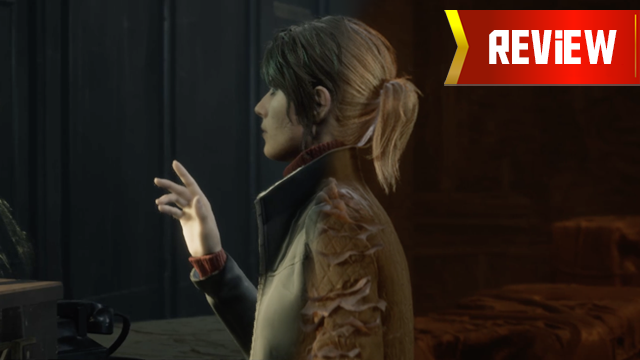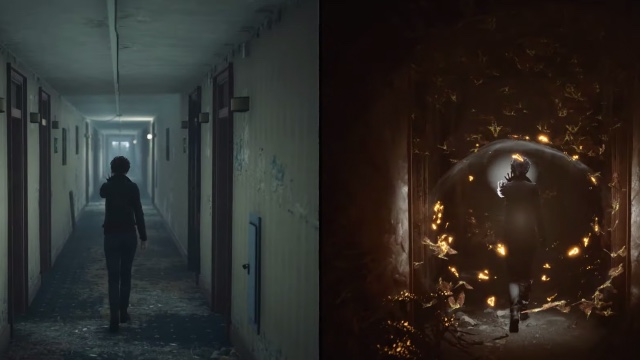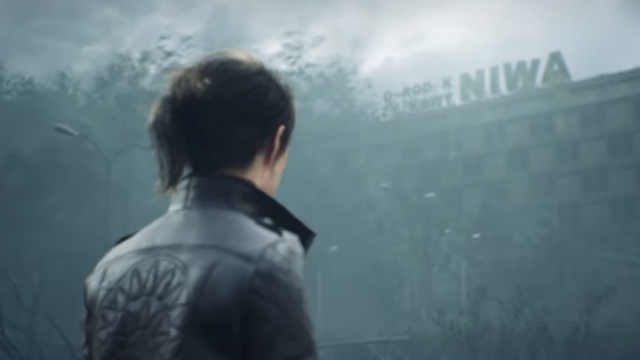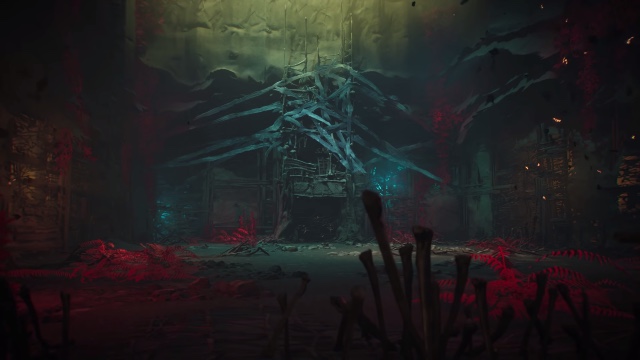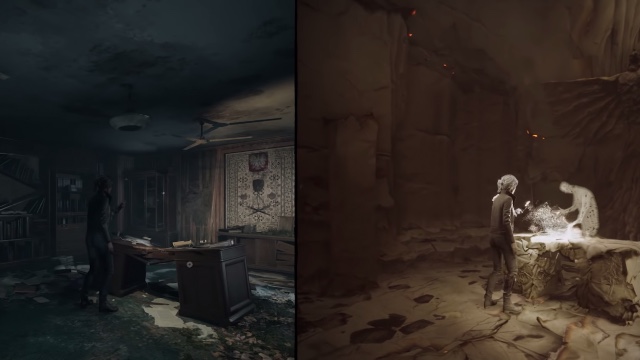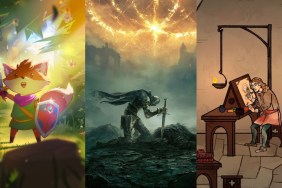The Medium review for Xbox Series X|S and PC.
The Medium is Bloober Team’s most ambitious title so far, but it sticks close to the studio’s roots. Initially announced in 2012, it was shelved to allow the technology to develop so the studio could tell the story it wanted to without compromise.
The ability to interact with two separate instances of a game world simultaneously, dubbed the Dual-Reality System, is The Medium‘s unique gimmick, which sets it apart from its horror contemporaries. This gameplay mechanic was the primary aspect of the game that was highlighted pre-release, but the big question was whether or not this would enrich its narrative or if it would be little more than fluff.
Best of Both Worlds
In The Medium, a spirit world lies parallel to the real world. Within the realm of spirits, emotion and intent are made physical. Though the two planes can interact with each other, they remain almost wholly separate as a rule. Our protagonist, Marianne, breaks this rule by existing as a single entity in two worlds. For her, the spiritual plane can be as easily explored and manipulated as the real world.
After her adoptive father’s death, Marianne receives a phone call beckoning her to Niwa Resort by Thomas, a man who claims to know her secret. Having sought answers as to why she has her powers, she makes her way to the long-abandoned facility. Upon her arrival, she becomes caught up in the aftermath of a tragedy that occurred there two decades before.
The Medium is a psychological horror game, Bloober Team’s specialty. However, unlike Layers of Fear 2 and Blair Witch, the plot is more grounded. Despite the fantastical notion of a spirit world, the game establishes a natural relationship between the two planes that follows specific rules. Marianne’s issue is that she, and the remaining inhabitants of Niwa Resort, don’t follow these rules.
Shortly after arriving at Niwa, Marianne is confronted with The Maw, an entity that is her opposite. This twisted creature originates in the spirit world but can manifest into the real world, at least for a while. It becomes evident after meeting it that The Maw intends to inhabit Marianne’s body so that it can finally fully enter the real world. Its origin and how to defeat it is a central thread of the game’s story.
A Bad Landing
I enjoyed The Medium more than Bloober Team’s most recent efforts, Layers of Fear 2 and Blair Witch. The story is more grounded and relies more on traditional horror techniques to build and maintain suspense. Bloober Team has relied too much on disorienting the player by rapidly switching environments and surreal elements in the past, and I’m glad that both of those narrative tools are almost entirely absent.
Unfortunately, the pacing is off. The game starts slow, and it wasn’t until around a quarter of the way through that it really started drawing me in. From there, the story was a crescendo that unfortunately dropped entirely off a cliff-edge in the last 20 minutes of the game. This is far from an issue that affects this studio, though. Many works of horror fumble the climax. However, the ending is an absolute letdown, which made me question the rest of the game’s validity.
I’m not someone who needs everything explained to me. I love theory-crafting and what-ifs. However, The Medium leaves the major plotlines of the game unfinished for seemingly no reason. You get to the goal, the mystery has been solved, and you’re just waiting for the denouement when the curtain drops.
Ambiguity works best when one or more plot points are open to interpretation, but The Medium ties everything together fairly neatly by the time you reach the end. This makes its lack of resolution incredibly unsatisfying, rather than intriguing and memorable.
Organic Brutalism
The environments in The Medium are excellent, especially considering that most of them had to be designed twice. The derelict Niwa resort combines Soviet brutalism with the haunting pastels of family-friendly design. The gray of the real world resort contrasts with the spirit realm’s organic browns and fleshy tones.
Seeing an environment in two variations is fascinating. Twisted metal and ruins in the real-world are bone and sinew in the spirit realm. A good portion of the game allows players to interact with both versions, and especially toward its finale, some puzzles require players to move between the two multiple times to solve them.
The inspiration the devs took from surrealist Polish painter Zdzisław Beksiński is evident when playing, as the spirit world is almost directly lifted from his paintings. I hope the game brings Beksiński to some new fans, as his work was on par with H.R. Giger, an artist who has been the inspiration for a variety of games over the years.
The spirits found throughout Niwa, including The Maw, are haunting and appropriately creepy. The friendlier ones still have decay about them, with crumbling flesh and roughly-hewn porcelain masks. On the other hand, the Maw has a powerful but horrific vitality about it, signifying its strength and ability to exist within both worlds. Troy Baker does an excellent job with the vocals of The Maw, who torments Marianne by beckoning her to let it wear her skin. The creature gives a real Buffalo Bill from Silence of the Lambs vibe, which never failed to make me uncomfortable.
The Medium makes use of fixed camera angles to heighten its scares. I’ve always been a fan of fixed camera angles in horror games because it lets the devs show you precisely what they want you to see. The limited viewpoint allows for excellent use of light and shadow, and The Medium‘s use of raytracing enhances that effect. However, raytracing isn’t required to make the game look beautiful. I found that RTX was glitchy for me on PC, likely because a The Medium-specific driver hasn’t been released yet by Nvidia. I turned it off, and the pre-baked lighting is still excellent.
Puzzling Gameplay
The Medium falls short in the time between its puzzles. It’s very linear, which means you’re only able to explore within each little box it puts you in. You basically move from one “puzzle box” to another throughout the game, with corridors linking them. There would be inventory management and combat in a survival horror title to soak up part of this time and keep the suspense up, but here there’s nothing but walking.
Because The Medium has no traditional combat, the pacing can become uneven outside of the stealth, puzzle-solving, and exposition. Even the stealth sections are brief and act more like puzzles than anything else. It ends up taking some of the suspense away, as there are clear demarcations between when Marianne is in danger and when she’s safe.
When you’re trying to get away from The Maw, you’ll inevitably find something to shock it with or a hole in a wall to crawl into, and the creature will just give up. The Maw is meant to seem like an ever-present danger, but the limited gameplay design leaves it toothless.
The Medium Review | Final Verdict
The split worlds mechanic in The Medium isn’t revolutionary, but it’s something I’d like to see again in a future title. The environments and the interplay between the real and spirit worlds are what makes this game unique, and it’s worth playing through it just to experience the excellent visuals and puzzles.
The Medium is a step in the right direction for Bloober Team and I hope that it’s a sign that the studio is moving out of its comfort zone. It’s definitely the most dynamic title from the devs so far. At its best times, The Medium channels Silent Hill, but the rough pacing and limited gameplay outside of puzzle-solving hold it back. Additionally, the unsatisfactory ending leaves a sour note that detracts from the overall experience.
-
Excellent environmental design.
-
Dual world gameplay is more than a gimmick.
-
Two-thirds of it is filled with great puzzles and interesting exposition.
-
One-third of it is plodding to get to the good parts.
-
Ending is awful.
